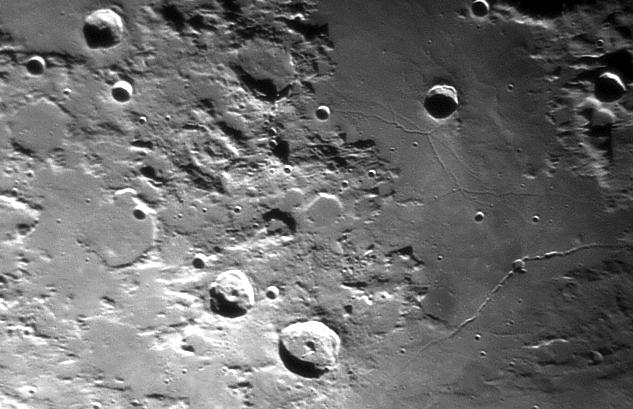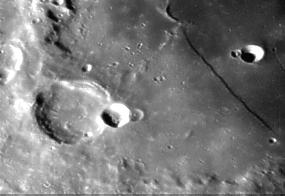Observing the Moon: Rills and Walls
Jack Kramer
They're not as famous as many craters, but they're of major interest to selenographers. They're both long, sinuous features that are probably the result of subsidence of the lunar crust. They're walls and rills (sometimes spelled as rilles), and many are visible with our telescopes.
What makes them of scientific interest is that they indicate something about the formation of the Moon and what lies under its crust. It's likely that the maria were caused by a flood of molten rock from beneath the surface of the Moon. It is widely held that rills -- those long, winding trenches -- were caused by the surface material falling into sub-surface voids that were channels for the flowing lava. And some rills give an indication that they were formed as surface lava channels. Selenographers also suspect that some could be fault lines caused by the shifting of sub-surface plates, like California's famous San Andreas Fault.
The CCD image below shows a number of rills to the south of Mare Vaporum. The most prominent is the Hyginus Rill, with another complex system of rills just to the east of the Crater Triesnecker. For orientation purposes, the largest crater in the lower middle is Agrippa. The Hyginus Rill is one of the few named objects of this type.

The best detail in a rill can be viewed when it lies perpendicular to the terminator. In these cases, the Sun shines more or less down the length of the rill, revealing details within it. If you look closely, many rills include a number of small craters. On the other hand, some objects look like rills at first, but under high magnification turn out to be a line of very small craters. These might have been formed as a meteoroid impacted the moon at an oblique angle and its material was strewn out into a line of craterlets.
A wall could sometimes be mistaken for a rill, but it's really more like a shelf where one large area has subsided, cleaving the surface and leaving a steep bluff. This is akin to a true fault line. It could also be mistaken for a scarp, which is just an extended mountain cliff. The following image shows the famous Straight Wall. The unique thing about walls that are oriented parallel to the terminator is that when illuminated from one side they appear black and when illuminated from the other side they appear brighter than the surrounding surface. This is easy enough to understand if you realize that in the former case we're seeing the shadow cast by the wall, and when it's bright we're seeing the Sun reflecting off the side of the wall. The image here was taken around the time of first quarter. Had it been a last quarter Moon, the wall would show as a bright line. Most of us don't usually see it bright because we tend to observe the moon during the evening rather than in the wee hours of the morning.

The Straight Wall lies at the eastern edge of Mare Nubium. The large crater in the above picture is Thebit. (South is up.) This wall is a classic example that rises about 1200 feet. But although it's not perfectly vertical, the grade is pretty steep --about 40%. It's most obvious when the Moon is just past first quarter. Observing an 8-day-old Moon with any scope, it stands out prominently and looks as though someone had painted a long, fairly straight line near the lunar central meridian. As the Sun climbs higher in the lunar sky, the Straight wall disappears from view.
From the surface of the Moon, a wall probably would look something like the following...
 Published in the April 1997 issue of the NightTimes
Published in the April 1997 issue of the NightTimes





